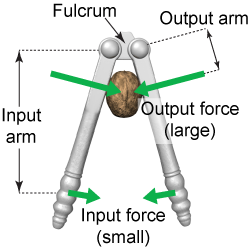|
 A lever can allow you to multiply your force to move a heavy object, but at what price? The lever is a machine for doing work that enables a tradeoff between forces applied and distances moved. If you make a lever with a long input arm, then you will also have to move the input arm by a large distance to move the load. Doubling the length of the input arm means that you can use half the force, but you also have to move the input arm twice as far.
A lever can allow you to multiply your force to move a heavy object, but at what price? The lever is a machine for doing work that enables a tradeoff between forces applied and distances moved. If you make a lever with a long input arm, then you will also have to move the input arm by a large distance to move the load. Doubling the length of the input arm means that you can use half the force, but you also have to move the input arm twice as far. 
|
 Nails driven into wood are difficult to remove because there is a strong friction force holding them in place. A claw hammer has a “V”-shaped wedge that is useful for removing nails. The claw hammer acts as a lever with a large input arm but short output arm. The input force from your arm is multiplied substantially to deliver a large force to remove the nail. As a tradeoff, however, you must swing the handle through a large motion in order to move the nail a short distance.
Nails driven into wood are difficult to remove because there is a strong friction force holding them in place. A claw hammer has a “V”-shaped wedge that is useful for removing nails. The claw hammer acts as a lever with a large input arm but short output arm. The input force from your arm is multiplied substantially to deliver a large force to remove the nail. As a tradeoff, however, you must swing the handle through a large motion in order to move the nail a short distance. 
|
 Most nuts have hard shells that are difficult to crack. A nutcracker is a lever that multiplies the force of your squeezing hand to break the shell. Your hand must squeeze through a larger distance than the crushing motion on the shell. Now look at the diagram more closely: Can you see a difference between the nutcracker and hammer in the arrangement of the forces and the fulcrum?
Most nuts have hard shells that are difficult to crack. A nutcracker is a lever that multiplies the force of your squeezing hand to break the shell. Your hand must squeeze through a larger distance than the crushing motion on the shell. Now look at the diagram more closely: Can you see a difference between the nutcracker and hammer in the arrangement of the forces and the fulcrum? 
|
As you may have discovered in Investigation 12A, there are three different classes of levers based on the location of the input and output forces relative to the fulcrum. The fulcrum lies between the input and output force for a first-class lever. The input force is further from the fulcrum than the output force for a second-class lever, whereas the output force is further for a third-class lever. All levers fall into one of these three classes. 
|

|
Which classes of levers are the claw hammer and nutcracker?
 |
The claw hammer is a first-class lever, because the input and output forces are on opposite sides of the fulcrum.
The nutcracker is a second-class lever, because the output force (on the shell) is located between the input force and the fulcrum. 
|
What classes of levers are the shovel, broom, and your arm when lifting a weight?
 |
All three are third-class levers.
For the shovel and broom, the fulcrum is located at the top (which you hold in place with one hand), your other hand applies the input force near the middle of the broom or shovel, and the output force is applied at the other end (at the bristles or scoop).
Your arm is a third-class lever when lifting a weight. Your shoulder acts as a fulcrum, your muscles apply the input force in the middle of your arm, and the weight is the location of the output force at the end of your arm. 
|

